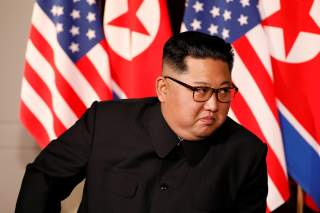The Hanoi Summit – We Asked Kate Hewitt What Happens Next in U.S.-North Korea Relations
"I foresee Trump delegating responsibility to his underlings while waiting to swoop in if an opportunity arises for an end-of-year summit."
Editor’s Note: Looking for more opinions on where we go after the Hanoi summit? Check out all 80 expert takes on where U.S-North Korea relations go next here.
Summits at the presidential level are unlikely in the coming year. America will largely rely on the U.S. Special Representative for North Korea, Stephen Biegun, and Secretary of State Mike Pompeo as the frontline negotiators throughout 2019. Given that President Trump has publicly vowed to “solve” the North Korea nuclear problem and been unsuccessful after two summits, it seems nuclear deals are proving to be a tougher nut to crack than building golf courses. Trump cannot afford to take the “L” on North Korea; he also cannot afford to walk away from a campaign promise that continues to flood national media. I foresee Trump delegating responsibility to his underlings while waiting to swoop in if an opportunity arises for an end-of-year summit.
That said, Biegun and Pompeo have their work cut out for them. Given that the mother of all deals seemed far-fetched this go-round, a tempered step-by-step process should be laid out. Any deal short of full denuclearization, which is unlikely given the current state of play, needs to focus on one goal: reducing risks that could lead to nuclear war.
With this goal in mind, a complete dismantling of all nuclear material production facilities at Yongbyon, coupled with a formal moratorium on intercontinental ballistic missile and nuclear testing, in exchange for partial sanctions relief should be on the table. Ensuring the complete, verifiable, irreversible dismantling (CVID) of the types of facilities at Yongbyon cuts off a huge portion of known plutonium production and highly enriched uranium sources. This, packaged with the testing moratorium—arguably the greatest threat to the continental United States and our allies—would be a prudent step. While this smaller deal would certainly not be enough to warrant complete sanctions relief by the international community, it would be a verifiable confidence-building measure that greatly reduces nuclear risk.
The United States should begin multilateral conversations on potential economic exchanges and partnerships with North Korea. This economic roadmap could outline what future benefits could accompany additional sanctions relief should Kim decide to disclose other nuclear facilities, like Kangson. This type of package offer will test the resolve of Kim, who has publicly expressed a desire to remove sanctions affecting his population while advancing his byungjin policy.
There are ways for Pompeo and Biegun to move forward in the coming year. Expect the Trump party line to be nothing but progress and victory for what will likely be small-scale, behind-the-scenes progress.
Kate Hewitt is an independent analyst on nuclear policy issues, a former Scoville Peace Fellow, a 2019 Nuclear Security Innovators Fellow, a contributing author to InkStick Media, or a research assistant at a nonpartisan think tank in DC. Her expertise is security and strategy with a focus on nuclear weapons policy, missile defense, Iran, North Korea, Russia and China. Her views are her own.
Image: Reuters

